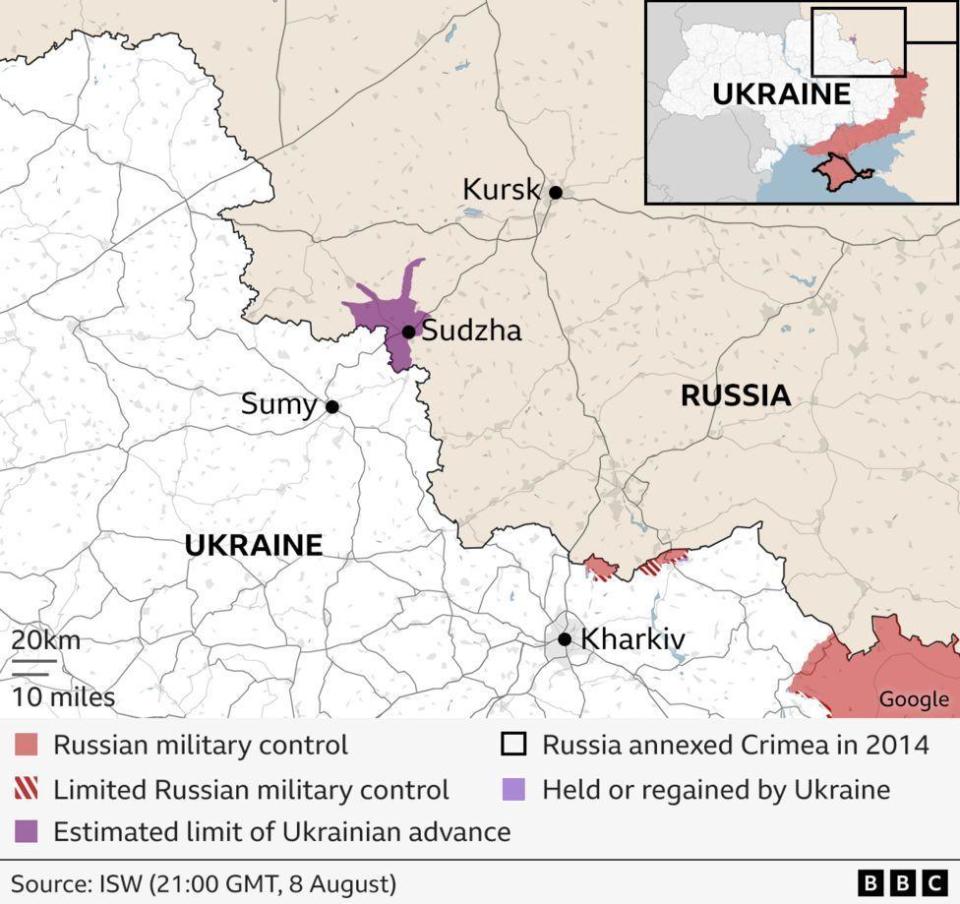Ukrainian troops advanced up to 30 kilometers into Russia in what became the deepest and most significant incursion since Moscow began its full-scale invasion of Ukraine in February 2022.
The Russian Defense Ministry said its forces faced Ukrainian troops near the villages of Tolpino and Obshchy Kolodez as the offensive in the Kursk region entered its sixth day.
Foreign Ministry spokeswoman Maria Zakharova accused Kiev of “intimidating the peaceful population of Russia.”
President Volodymyr Zelensky, who directly acknowledged the attack for the first time in a speech last night, said that 2,000 cross-border attacks were launched by Russia from Kursk this summer.
“Artillery, mortars, drones. We also record missile attacks, and each of these attacks deserves a fair response,” Zelensky told the country in his evening speech in Kiev.
A senior Ukrainian official told the AFP news agency that thousands of soldiers were involved in the operation, far more than the small incursion initially reported by Russian border guards.
Although Ukrainian-backed sabotage groups have launched intermittent cross-border incursions, the Kursk offensive marks the largest coordinated attack on Russian territory by Kiev’s conventional forces.
“We are on the offensive. The objective is to expand the enemy’s positions, inflict maximum losses and destabilize the situation in Russia, as they are unable to protect their own border”, said the official.
Russia’s Defense Ministry said on Sunday that its forces “thwarted attempts by enemy mobile groups with armored vehicles to penetrate deep into Russian territory.”
But in an apparent admission that Kiev’s forces had advanced deep into the Kursk border region, the Defense Ministry reported the involvement of Ukrainian troops near the villages of Tolpino and Obshchy Kolodez – which are about 25km and 30km from the Russian border. -Ukraine.
Images circulating online and verified by the BBC also appeared to show a Russian attack near the village of Levshinka, about 25 kilometers from the border.
Ukrainian troops claimed to have captured several settlements in the Kursk region. In Guevo, a village about 3 kilometers from Russia, soldiers filmed themselves removing the Russian flag from an administrative building.
Videos have also emerged of Ukrainian troops seizing administrative buildings in Sverdlikovo and Poroz, while heavy fighting was reported in Sudzha – a town with around 5,000 inhabitants.
Ukrainian troops have already filmed themselves on the outskirts of Sudzha, at an important gas installation involved in the transit of natural gas from Russia to the EU via Ukraine, which continued despite the war.
In the Sumy region, which borders the Kursk region, BBC reporters witnessed a steady stream of armored vehicles and tanks moving towards Russia.
The armored convoys sport white triangular insignia, apparently to distinguish them from equipment used in Ukraine itself. Meanwhile, aerial photos appear to show Ukrainian tanks engaged in combat inside Russia.
Photos analyzed by BBC Verify also appeared to show Russia building new defensive lines near the Kursk nuclear plant. Ukrainian forces engaged at Obshchy Kolodez were 50 km (31 mi) from the installation.
Contrasting satellite images of the same location captured yesterday with images from a few days earlier, the images show several newly constructed trenches nearby, with the closest about 8 km (5 miles) from the plant.
Russia says 76,000 people have been evacuated from the border areas of the Kursk region, where a state of emergency was declared by local authorities.
Acting regional governor Aleksei Smirnov also said 15 people were injured on Saturday night when debris from a downed Ukrainian missile fell on a multi-story building in the Kursk regional capital Kursk.
Oleksiy Goncharenko – a Ukrainian MP – welcomed the operation and said it was “taking us much closer to peace than a hundred peace summits”.
“When Russia needs to fight back on its own territory, when the Russian people are on the run, when people care, this is the only way to show them to stop this war,” he told the BBC.
The Kursk offensive comes after weeks of Russian advances in the east, where a succession of villages have been captured by Kremlin forces.
Some analysts have suggested that the attack on Kursk is part of an effort to force Russia to redeploy forces away from eastern Ukraine and ease pressure on Ukraine’s beleaguered defenses.
But the Ukrainian official told AFP there had so far been little respite from Russian operations in the east.
Earlier this week, Russian President Vladimir Putin said the offensive was a “major provocation.”
Meanwhile, emergency services in the Kiev region said a man and his four-year-old son were killed in a missile attack near the capital overnight.
Air defenses also destroyed 53 of 57 attack drones launched by Russia during nighttime airstrikes, Air Force officials said. Four North Korean-made missiles were also fired as part of the barrage, they said.
Russia was forced to turn to the isolated Asian state to resupply its ammunition, with the US alleging that large quantities of military equipment were sent by Pyongyang.
Elsewhere, Russian authorities in occupied Zaporizhzhia Oblast said a fire broke out at the region’s nuclear power plant on Sunday.
Yevgeny Balitsky, the Kremlin-installed governor of Zaporizhzhia, said the fire broke out after shelling by Ukrainian forces. He said there was no radiation spike around the plant and that crews were controlling the fire.
In a statement published on for nuclear safety.
President Zelensky said in a social media post that Russian forces started a fire on the territory of the plant.
The site has been under the control of Russian troops and authorities since 2022. It has not produced power for more than two years and all six reactors have been cold shut down since April.
With additional reporting by Benedict Garman.




















/cdn.vox-cdn.com/uploads/chorus_asset/file/23999417/acastro_STK459.jpg?w=300&resize=300,300&ssl=1)










